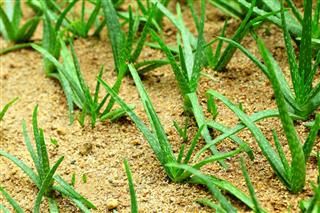
One of the popular medicinal plants, aloe vera is now widely grown for both therapeutic as well as ornamental purposes. Though this plant does not require diligent care, some basic requirements have to be met if you want to grow healthy ones.
Aloe vera plants are native to Africa and grow well in arid climates. With a little care, you can grow them in your home garden. Even though it is best as an outdoor plant, aloe vera is good for indoor gardening too, provided it gets sufficient light to grow. While those grown indoors may not flower, some of the outdoor plants may produce white, yellow, or orange blooms during summers.
How to Care for Aloe Vera Plants
It is not difficult to grow aloe vera at home, if you know the right methods. Aloe Vera plants can be bought from local nurseries or garden stores. Make sure to get healthy ones with no marks, blemishes, or spots. Those with dropping leaves must also be avoided. Older plants can be identified with overcrowded roots that may sometimes grow out of the pot. Avoid such plants too. Once you choose a healthy aloe vera, the next step is to plant it in a container. Some of the vital factors that affect the healthy growth of these plants are sunlight, water, and soil type.
Aloe vera plants need bright light for their growth, but harsh sunlight can sometimes damage the leaves. Dark brown or orange spots may appear on the leaves, indicating sunburn. These spots may be flaky and in some cases, the entire leaf may turn orange. Hence, it is better to keep the plant in a shaded location with indirect sunlight. If you want it as an indoor plant, then make sure that it gets sufficient bright light. You can keep it near an east- or west-facing window. If the pot is placed on a windowsill, then try to avoid direct sunlight. During winters, keep the plant indoors and ensure that it gets enough bright light.
The soil for planting aloe vera should be well-drained. A potting mix with sand, pumice, and perlite is suggested. Nowadays, commercial potting mixes are also available. You can go for pre-packaged ‘cacti and succulent mix’, as it facilitates good drainage. Diluted plant foods can be used (once a year) during spring. For indoor plants, an organic kelp fertilizer or worm castings will be beneficial.
Aloe vera has fleshy leaves, which enable the plant to store water. Hence, the water requirement of this plant is very low and over-watering can cause rotting. Water this plant only when the soil is dry. You can water it once or twice a month and very scarcely during winter. Always grow this plant in pots with drainage holes, as these holes help to drain out excess water.
A healthy aloe vera plant grows very fast and produces many shoots. If the plant has outgrown the pot and the pot is filled with roots, then you can start repotting. Don’t allow the new shoots to grow beyond 3 to 4 inches, as these shoots suck energy from the mother plant. This affects the health of the mother plant, which develops horizontal growth of leaves. Hence, remove the shoots when they are 3 to 4 inches long and replant them. It is beneficial to use terracotta pots, as they are porous and allow water drainage. It is better to go for wider pots rather than deeper ones, because the roots of this plant do not grow deep.
Water aloe vera plants at the time of replanting and avoid watering for the next three weeks. It is normal for these new plants to change their color to gray or brown, during the initial stages of replanting. If the leaves are growing flat, try to provide bright light. If the growth rate of the plant is very slow, then change the potting mixture and stop using fertilizers. Aloe vera plants cannot stand frost or snow. Hence, keep it indoors during such conditions.
Aloe Vera Problems
Though it is easy to grow aloe vera plants, unfavorable conditions may cause different problems-
- The most common among them are discoloration and/or drooping of leaves. In such cases, you must suspect improper drainage, problems with access to light, or exposure to cold weather.
- Though these plants need less water, total lack of hydration may make the leaves thin and curled. A slow-growing aloe vera may indicate over-watering or excess feeding.
- Even lack of light and highly alkaline soil may slow down the growth of this plant.
- If you want to harvest the leaves, go for the ones which are closest to the ground. However, make sure to use the clear gel inside the leaves, as the yellow sap beneath the green skin is toxic.
- It is said that the yellow sap of aloe vera leaves may cause contact dermatitis in some people. So carefully remove the green skin and the yellow latex, before using the inner gel.
- Ingestion of the yellow juice of aloe vera may cause abdominal cramping, diarrhea, and red urine. This plant (if ingested) is also toxic for pets like cats and dogs.





